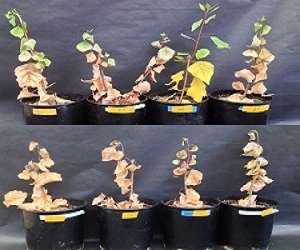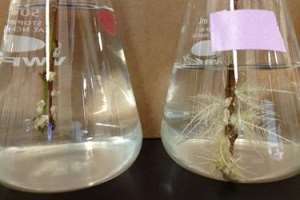By Michelle Ma

With California in its fifth year of severe drought and many western states experiencing another year of unusually dry conditions, plants are stressed.
Agricultural crops, grasses and garden plants alike can get sick and die when factors such as drought and excess sun force them to work harder to survive.
Now, plants can better tolerate drought and other stressors with the help of natural microbes, University of Washington research has found. Specifically, plants that are given a dose of microbes stay green longer and are able to withstand drought conditions by growing more leaves and roots and using less water.
“Plants are less stressed if they have these natural microbes,” said senior author Sharon Doty, a UW professor of environmental and forest sciences. “They will help plants deal with environmental challenges, especially with climate change.”
The findings were published online this month in the journal Current Plant Biology.
Microbes and their benefits to plants is a burgeoning field, and Doty’s lab in the last 15 years has explored many different aspects of this mutual symbiosis. Earlier this year, her team demonstrated that microbes in plants help them grow in otherwise inhospitable environments — essentially serving as a natural fertilizer.
Naturally providing nutrients and boosting drought resistance could make it easier and more environmentally friendly to grow grain and vegetable crops, fruit and nut trees, and even keep golf courses looking lush and green without using excess amounts of water and chemical fertilizer.
“The more I learn, the more I do research in this field, the more exciting it gets, especially in the applied aspects,” said lead author Zareen Khan, a UW research scientist in environmental and forest sciences. “I think this knowledge can be used to develop strategies to face the challenges of climate change.”
In this study, the researchers looked at the ability of young poplar trees to tolerate drought conditions over a month-long period, with and without the help of added microbes, called endophytes, bacteria that live inside a plant without causing disease.
Researchers inoculated the young poplar cuttings with a cocktail of microbes isolated from wild poplar and willow trees growing in unfavorable conditions. They poured the mixture at the base of the stems of 10 poplars, while the other 10 cuttings did not receive any microbes. After a short growth period in a greenhouse, all 20 plants were subjected to drought conditions for a month.
It’s important to note that all of the poplars had microbes inside — they are naturally present in every living thing. But when the researchers added microbes from wild poplar and willow, they noticed a benefit to the plants.
Specifically, the poplars that were given the probiotics doubled their root biomass and experienced nearly 30 percent more leaf and stem growth than poplars without the added microbes. When exposed to drought conditions, the poplars with microbes also stayed green with robust leaves and stems, while their counterparts browned and wilted.

“Plants are overall greener and healthier if they have these microbes,” Doty said.
The researchers chose poplar trees to demonstrate this beneficial relationship because the fast-growing trees are important for biofuels, or plant-based renewable energy.
“One of the limitations of biofuel is large-scale production,” Khan said. “If we can reduce water usage on poplar-tree plantations by adding naturally occurring endophytes, then that could provide huge economic and environmental benefits.”
Microbes also help crop plants such as tomatoes, corn and peppers be more tolerant of drought. The researchers are collaborating with an engineering company, Intrinsyx Technologies, to show this same beneficial relationship between microbes and agricultural plants, with crops given the beneficial microbes yielding more vegetables and responding better in dry, hot weather.
“Having microbes that can help plants establish early, grow fast and protect them from some of the stresses in their environment, especially drought, is a big deal,” said John Freeman, chief science officer at Intrinsyx who works with Doty’s team at the UW. “Using these endophytes in agricultural settings holds a lot of promise for growers and farmers.”
The researchers suspect a number of factors are at work. Microbes enable plants to accumulate more nutrients like nitrogen and phosphorus. The microbes also help plants use water more efficiently, and even produce molecules that promote plant growth and help them stay green.
Gaining more root, stem and leaf mass also makes plants able to store more water.
“Endophytes are helping plants make more roots, so they have more surface area to hang onto water and survive the stress of drought longer,” Khan said.
Next steps include better understanding exactly how microbes bolster plants, and finding the best strains to help different plants deal with various stresses.
“Finding the most beneficial ones for the job is the key in using this technology,” Khan said.
Other co-authors are Hyungmin Rho, Shang Han Hung and Soo-Hyung Kim of the UW’s School of Environmental and Forest Sciences; Andrea Firrincieli of the University of Tuscia in Italy; and Virginia Luna and Oscar Masciarelli of Universidad Nacional de Río Cuarto in Argentina.
This research was funded by the U.S. Department of Agriculture.
Source: washington.edu